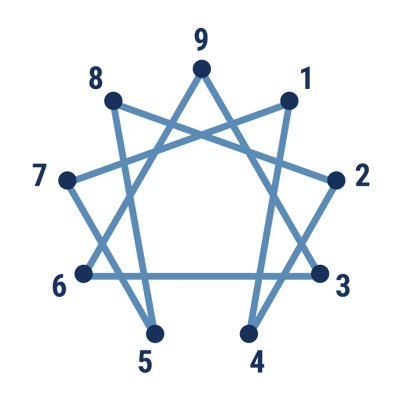As many of you know, Transform has been working with the Somatic—or more embodied—side of the transformational equation for years. We are fascinated by what we believe this type of work has to offer in terms of integration, healing, and the possibility of growth.
Personally, I’ve found a description of the Somatic work difficult to put into words since it’s very experiential, so I asked my Somatic coach and friend, Kerry, to explain it specifically to our Enneagram clients and friends.
I love what she had to say and hope you become intrigued. Let me know what you think!
Onwards,
Mary Anne
PRINCIPAL, TRANSFORM, INC.
The Enneagram and Somatic Experiencing
By Kerry O’Donnell
When we get triggered by something that “pushes our buttons” it can feel like a rush of energy, rapid heart rate, sweating palms and a desire to fight back or run away; or we can freeze and go numb. These are responses of the nervous system designed to protect us from physical and emotional pain. We all have basic needs for safety and security, belonging and worthiness, and maintaining relationships through connections to others. The Enneagram map points the way to what causes our individual reactivity based on habitual ways of thinking, feeling, and sensing. The nervous/sensory system cannot distinguish between real and perceived threats, and the reality is that much of the time and for most of us, the threat is perceived— that is, based on old patterns according to our Enneagram type.
Each of us tends to get triggered when we come face to face with what we habitually avoid according to our type. (Ones: being wrong/making mistakes; Twos: own needs/rejection; Threes: failure/disapproval; Fours: mundane/inadequate; Fives: incompetent/not knowing; Sixes: uncertainty/unpredictability; Sevens: pain/limitation; Eights: vulnerability/weakness; Nines: conflict/separation). What we avoid feels dangerous so when we’re faced with it, the nervous system responds with versions of fight, flight, or freeze (which we often physically feel) in attempts to protect us. When it’s not processed, that energy becomes stuck or trapped, to be triggered over and over again, and we can be highjacked by it. In this way, the Enneagram is the map, and the nervous system is the territory.
Somatic Experiencing (SE) provides methods and skills for how to work with this trapped energy and to rewire the “if…then” polarity of sensory “beliefs” that were wired together in the neural networks of each Enneagram type. For example, the One believes “If I make a mistake or I am wrong then I will be bad or defective”; the Two believes “If I have my own needs then I will be unworthy of love”; the Three believes “If I have my own feelings then I will have no value”; the Four believes “If I am ordinary then I will have no identity”; the Five believes “If I am comfortable in my body then I will be incompetent”; the Six believes “If I trust myself then I will be without security or guidance”; the Seven believes “If I am not okay then I will be trapped in pain or deprivation”; the Eight believes “If I am weak or vulnerable then I will be harmed or controlled”; the Nine believes “If I assert myself then I will be disconnected and cut off”; and for every type, the sense is: …. and I will not survive.
Our personality type is an adaptive survival strategy that served us well in childhood but causes pain and limitations in adulthood. When you remember a time when you were triggered, strong emotions often arise again in the present moment because the nervous system doesn’t know the difference between real and perceived. The internal energy that was originally mobilized to protect you is trapped, which creates barriers to receptivity and growth. The focus lies on removing those barriers to expand your internal and external awareness, increase your receptivity, and provide more options and choices other than your old patterns. There are several ways to work with the nervous system:
- Emotional “name it to tame it” immediately links and integrates the left hemisphere of the brain with the right
- Locating the emotion in the body as a physical sensation allows you to skillfully titrate the energy in order to re-integrate it
- Learning to access your other two non-dominant centers of intelligence
- Bringing in evidence contrary to your worldview and self-identity generated by your nervous system (and therefore at a pace it can accept), allowing you to reclaim and re-integrate the parts of yourself that you had to disown in order to be loved and accepted by caregivers.
The nervous system is fully formed by 18 months old, and its primary job is to protect us. By contrast, our prefrontal cortex (seat of awareness) is not fully formed until we are in our mid-20s. Until we learn how to link the two, our nervous system is running the show whenever we are triggered by anything that “pushes our buttons.” The great news is that through somatic work that links our conscious awareness (prefrontal cortex) directly with what is happening in our nervous system, we can literally re-wire the architecture of our brain and heal the reactive parts of our Enneagram type.
——
Kerry O’Donnell may be reached at kerryjodonnell@gmail.com.
Kerry is a certified (Enneagram Worldwide) and accredited (International Enneagram Association) Enneagram Professional Teacher and Coach, certified Somatic Experiencing® Practitioner (Dr. Peter Levine, Trauma Institute, https://traumahealing.org), and Senior Certified Professional in Human Resource Management (SHRM-SCP). She has over 25 years of experience working for the United States Institute of Peace, Council for International Exchange of Scholars, and American University in Washington, D.C.; and she served as President of the Maurice Falk Medical Fund and Falk Foundations in Pittsburgh. Kerry holds a Master’s degree in Education with graduate certification in Traumatic Stress Studies (Bessel van der Kolk).




